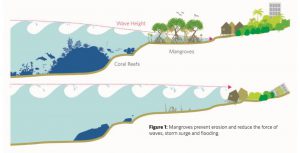![]() Mangrove forests serve as natural coastal protection and reduce annual flooding to more than 18 million people. Through the dense vegetation, they reduce the effects of natural disasters in the hinterland (Figure 1). Mangroves can reduce wave heights by 50 – 100% over a 500-meter-wide mangrove belt. Similarly, mangroves help to stabilize coastlines and reduce coastal erosion by reducing the height and energy of waves, thus minimizing erosive forces on sediments (Losada et al., 2018).
Mangrove forests serve as natural coastal protection and reduce annual flooding to more than 18 million people. Through the dense vegetation, they reduce the effects of natural disasters in the hinterland (Figure 1). Mangroves can reduce wave heights by 50 – 100% over a 500-meter-wide mangrove belt. Similarly, mangroves help to stabilize coastlines and reduce coastal erosion by reducing the height and energy of waves, thus minimizing erosive forces on sediments (Losada et al., 2018).
Mangroves play an important role in disaster control and adaptation to climate change, especially in countries of the global south. In places where mangrove forests have already been destroyed, the loss of natural coastal protection must be compensated by expensive flood control measures. Or, nothing is done, and the coastal communities are simply exposed to the vastly increased risks posed by the ocean.
An example, for the devastating effects of loss are the Philippines. Measured by the current population – the mangroves that were lost between 1950 and 2010 have led to an increase in flooding to more than 267,000 people per year. The restoration of these mangroves would provide flood protection of more than $ 450 million a year. Further destruction of existing mangroves (data of 2010) would expose 24% more people to flooding each year – meaning another 613,000 people, of which many live in poverty (Menéndez et al., 2018).
